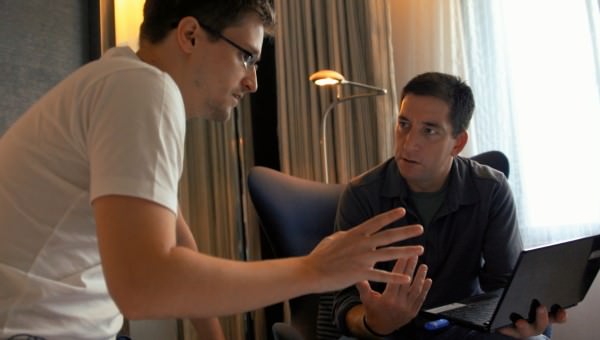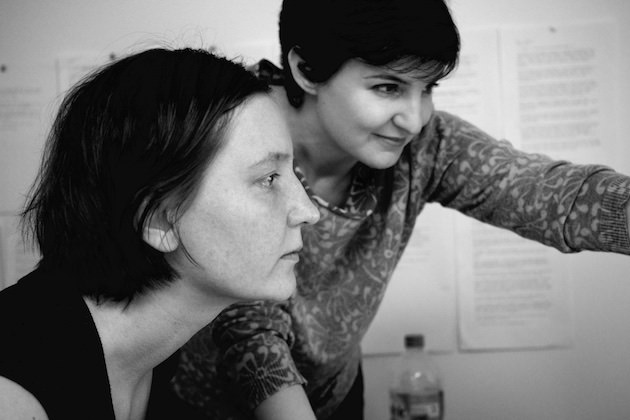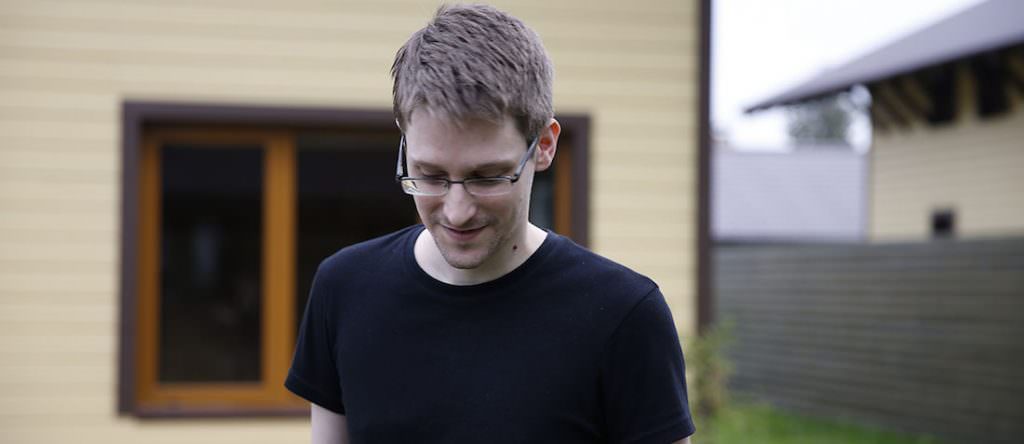Inherent Risk: Editor and Producer Mathilde Bonnefoy on Making Citizenfour
When documentarian Laura Poitras asked Edward Snowden why he had chosen her, out of all the potential people to disclose his information to, he replied, “I didn’t. You chose yourself.” At the time Snowden was writing to her as “citizen four,” and for months Poitras alone knew about his trove of information on the N.S.A.'s surveillance program.
Eventually, as we learn in Citizenfour, the Oscar-nominated documentary that culminated from her relationship with Snowden, along with journalist Glenn Greenwald, Snowden’s assessment of Poitras as the ideal individual to help him reveal his documents about the government's massive, amorphous covert surveillance program was shrewd. Poitras, along with her collaborators like editor and co-producer Mathilde Bonnefoy, made a documentary as riveting and unsettling as you would expect about our government’s abuse of technology in the name of security, with an undeniably captivating “protagonist” (or antagonist, depending upon your politics) in Snowden. “He’s certainly the most extraordinary protagonist, that’s for sure, but I have a reluctance to call him a protagonist because he’s real, his life is real," says Bonnefoy. "He’s in dire straits, he’s stranded in Russia where he does not want to be, his future is uncertain, so it’s really difficult for me to see him as character." Yet Snowden is, undeniably, an incredible figure to center a film on; eloquent, intelligent, and willing to detonate his own life for a cause.
More so than anybody else on the planet perhaps outside his girlfriend, Bonnefoy has spent many hours alone with Snowden, in the editing bay, watching the footage that Poitras captured of him. As a filmmaker, Bonnefoy was grateful that Snowden was so charismatic, but she was very clear on how truly moved she was by him as person, and cannot think of him as merely the protagonist of the documentary that changed her life. “There’s something very transparent about him. I was looking at the footage, and there’s a lot of it, and there doesn’t seem to me to be any ambivalence about him, which is very beautiful and very fascinating. It creates a screen presence that is very compelling.”
One of the first things that Bonnefoy pointed out, when asked her how she had managed to edit a film that was little more than a series of interviews into something as riveting and unsettling as Citizenfour, was to correct my memory of how the film actually played out. It is not a series of interviews, but rather a vividly tense and uncanny portrayal of ordinary individuals (if you can call people like Snowden, Poitras and Greenwald ordinary) in extraordinary, at times terrifying circumstances. “It’s cinéma vérité, which means that we see things as they are happening,” she said. “There’s just one little moment in the beginning in Hong Kong when Snowden answers questions from Glenn [Greenwald] when he’s questioning him, but after that it really feels like more of a fiction film than anything else.”
While the film clearly owes some of its power to the fact that we now know how much real dirt Snowden had on the N.S.A., and the massive, global news story his leak became, that alone could not have made the documentary as thrilling and darkly satisfying as it is. Citizenfour manages to capture the nervy and very real danger that surrounded Snowden and, to an extent, Poitras and Greenwald, as they were making the film. In its understated and elegant way, the film has the energy of a spy thriller, heightened by very real, very frightening risks. Daniel Craig fighting atop a speeding train as James Bond has nothing on Edward Snowden, Glenn Greenwald and Laura Poitras in a hotel room in Hong Kong, wondering if the suddenly blaring fire alarm is a cover to flush them out and arrest them for the materials in their possession. The paranoia they feel in that moment is palpable, and utterly understandable. Greenwald and Poitras are working with an individual the U.S. government will likely view as a traitor, and the crime they will charge him with will carry significant consequences for not only himself, but the people he worked with. It is also the rare documentary that created it’s own narrative momentum; Poitras filmed Greenwald and his Guardian colleague Ewen MacAskill talking to Snowden, Greenwald would then report on those conversations, both for The Guardian as well as on TV, the world would react, and this reaction would shape the contours of the film as it hurtled forward to Snowden’s unknown and very likely grim future.

Poitras chose Bonnefoy in part because she could bring her experience editing narrative fiction films to a documentary. “Coming from fiction, the idea was to communicate the experience of making this film on an emotional level. Not so much from an informational level, with people telling you facts, but as something we lived through. This is where the cinéma vérité style came in—the camera person is a fly on the wall, and the viewer is in the midst of a situation as it’s unfolding. We could have gone in another direction, as Laura had shot all these interviews and we could have used those interviews, but we ended up with the only interview being that original debriefing of Snowden by Glenn. We had so much great interview footage of Snowden, who is so eloquent, but we decided not to use it. The film starts with the tunnel into Hong Kong as you hear Laura’s voice reading out the letter from Snowden, and the idea was to pull us into an atmosphere and state of mind.”
It wasn’t meant to be this way. Poitras was already working on a documentary on surveillance, one she’d been at for years, and had compiled an impressive roster of interview subjects, including Julian Assange, the Wikileaks editor-in-chief. This was all before her life, and the lives of her collaborators, would be irrevocably changed when she was contacted by someone calling themselves Citizen four.

“Laura got contacted by Snowden after she was already here in Berlin. She’d been detained repeatedly at the U.S. border, and she was aware in a very personal way that there was a police state going on that was a consequence of the reaction to 9/11, and her work was focused on post 9/11 policy, and she was drawn into surveillance doing that work, which is how Snowden became aware of her,” Bonnefoy says. “She’d done a very short film in the New York Times about William Binney, and so one of the things that made Snowden aware of Laura was that he saw the film, and that she’d covered one of the important protagonists about surveillance, so he contacted her. (Poitras’ OpEd and accompanying video about Binney was a part of a series by independent filmmakers who had received grants from the BRITDOC Foundation and the Sundance Institute. Watch that video here.)
Binney, who is also in Citizenfour, was an employee of the NSA for many years, one of the agency’s most well respected mathematicians and code breakers, only to become one of their chief antagonists, before Snowden exploded onto the scene. For his efforts in trying to expose the N.S.A.’s surveillance program, Binney’s been hassled, harassed, litigated against, and had his home raided and been held at gunpoint. The government’s case against him eventually collapsed. His years of torment at the hands of the government was something Snowden, Poitras and Greenwald were keenly aware of. Greenwald’s reporting reveals that 1.2 million individuals are currently on a U.S. government watch list—a list that includes Poitras.
“This is more deeply a film about courage,” Bonnefoy says. “Laura was always interested in people who were, in a way, ordinary, but faced with extraordinary circumstances, and the question she asks herself is, What do they do in these extraordinary circumstances? That’s something that’s very fascinating. I must say when I was watching the footage of Snowden for the first time, I was extraordinarily moved. Even just listening to him talking to Glenn, with his childlike innocence and friendliness, it was such a huge decision he made, and he was not naïve about it, he was clearly taking into account the fact that, as he said, the best case scenario was imprisonment for life, so he was taking into account he could be murdered. Laura actually never watched the footage alone, she asked me to do it, so I spent weeks and weeks looking at the footage and feeling awe, and great responsibility.”
Regardless of your politics, or your opinion on whether Snowden is a hero or a turncoat (or something in between), it is very close to impossible to watch Citizenfour and not feel, in the very least, that his grief over the N.S.A.'s surveillance is genuine. What is more opaque is his motivation for essentially ending his life. While he explains how disgusted he is that the internet has gone from a place where one could, anonymously, seek connection and information, to a highly monitored tool that allows for government agencies and corporations to collect, file and use our data, the film spends little time digging more deeply into his thinking. Some critics have pointed out that Snowden’s real motivations, or perhaps more accurately the totality of his motivations, weren’t properly explored by Poitras. Yet as Bonnefoy explains, they had many hours of interview footage (there was something like 10 or 11 hours of Snowden alone) they didn’t use, and what the film presents is at once a truer depiction of Snowden the individual, as well as the realities of what he was revealing to Poitras, Greenwald and, ultimately, the rest of us, than a film that was a series of questions and answers, and an attempt to unpack Edward Snowden's mind.
“I’ve heard people say they wanted to hear more from him, but in a way it’s because we’ve become used to, especially in cinema, explanations, to character depictions that rely upon often quite simplistic psychological information. So yeah, one could look for things and try to derive some kind of psychological development and say, Oh now I understand him, but we’ve been fed these psychological details to give us a feeling we understand someone, but in reality we understand people intuitively, that’s what we do in life, we don’t need to know if they had a happy childhood to get a sense of people. So when Snowden says he’s doing it because he’s fearful for the future of democracy, and he remembers a time when the internet was free and anonymous, that’s his motivation. But for so many people it feels like it cannot be the case, but no, I think it can be the case. Of course one wants to be a psychoanalysis of Snowen, to look for clues, but in a way what it is to understand someone? My response would be to trust one’s instincts.”
The sense you get watching the film that Snowden is being genuine is something Bonnefoy says we, as the viewer, need to trust. “You meet someone in real life, you say hello, in the first few seconds you can feel whether they’re being straight forward, genuinely friendly, or whether they feel a malaise or fear. It’s the same with footage; if the footage is good enough, which was the case here, I just think you can feel in a matter of seconds that he was completely authentic and sincere with what he thinks. Completely. And this gives it this weight, because you feel someone who has really done something completely heroic. You see someone who has decided to probably end his life as he knows it, or die, for the good for others, or at least what he thinks is the good of others.”
Although Snowden is remarkably calm throughout the film, having had lived with the consequences of his decision for a long time before there were cameras present, there are still moments of real fear throughout. The aforementioned pesky fire alarm at the hotel makes him visibly paranoid, as well as the moment when he needs to be spirited out of the hotel and, for all intents and purposes, go on the run. Citizenfour plunges you not only into the life-obliterating risk Snowden is taking, but the very real risks Poitras and Greenwald are taking as well. Bonnefoy says that she hopes those risk won’t be in vain.
“Hopefully it should change everyone’s life, because we are all under surveillance. We’re not targets of individual surveillance, as Laura and Glenn and her close circle are, but of course, if you belong to a minority who’s already under suspicion, you are, and still, we’re all under default surveillance. It’s highly, highly dangerous, and our privacy is completely gone, and for everyone to be aware of this and use the tools they have, like encrypted email, is important. If you use non-encrypted email, it’s like a post card. Encrypted email, which is very easy to set up, is like sending a letter with an envelope.”
Editing Citizenfour has had a lasting effect on Bonnefoy, which is hardly surprising. Simply watching the film has the ability to make you feel suddenly exposed, and very angry. Bonnefoy can no longer look at technology the same way. Poitras thrust her into a brand new world in which she was suddenly encrypting all her communication about the film, removing phones from any room where they were showing it, and keeping the number of people they could screen it for to a very, very select few. “We moved outside out of the house to discuss any controversial matters during editing, and, as you see Glenn and Snowden doing in the film, we also were writing notes on paper to each other instead of speaking. My husband and I both realized while we were working that it was very likely our home was under surveillance, or, if not, our electronics certainly were because of being in contact in Laura."
The making of the film was done with such secrecy and care that it practically came out of nowhere when he debuted at the New York Film Festival, stunning audiences, many of whom thought they knew all there was to know about Snowden and his revelations. On a personal level, Bonnefoy no longer writes on her normal computer. “I now use an air-gap computer,” she says, referring to a computer or network that are not connected directly to the internet or any other computers that are. “I have a little sticker over my laptop camera.” She says that now that the film is out and she’s moved on to other projects, she and her husband have relaxed a bit, but that “there’s no going back to that state of ignorance as it was before.” Bonnefoy says she has lost the assumption that the internet was more or less anonymous, and she now uses an anonysmizing browser to look up anything that’s remotely private on the internet.” There’s one that’s really very good, used by activists and political dissenters that’s called Tor, it allows you to browse the internet that does not reveal your IP address. People can’t trace your searches back to you, and it doesn’t get added to this big profile that’s being made now.”
Bonnefoy came away changed from her part in helping make Citizenfour in another, equally profound way; it reminded her of the importance of art in interpreting life.
“Working with Laura got me into a mode that was different than before, the extraordinary thing about editing this film was the events we were integrating into it were happening as we were editing. We were editing then Snowden contacted Laura, then we were editing as we went to Hong Kong, then we were editing while the world gasped in astonishment at the very story we were editing. We were being constantly jolted by things that were happening, so the question was constantly, Should we film this? It was very chaotic, and we were actually advancing more or less blindly as we had no idea where this was taking us. What I was reminded of, in a very clear way, was how art is necessary in life to understand what's happening to us. We were transforming these events as they were unfolding into art, and in doing so we were reinterpreting them in order to communicate them to an audience, but we were also making them understandable to ourselves. I was able to see what the function of the art is, and how we use it to interpret what’s happening.”
CITIZENFOUR will debut on HBO on Feb 23rd at 9:00pm ET/PT




